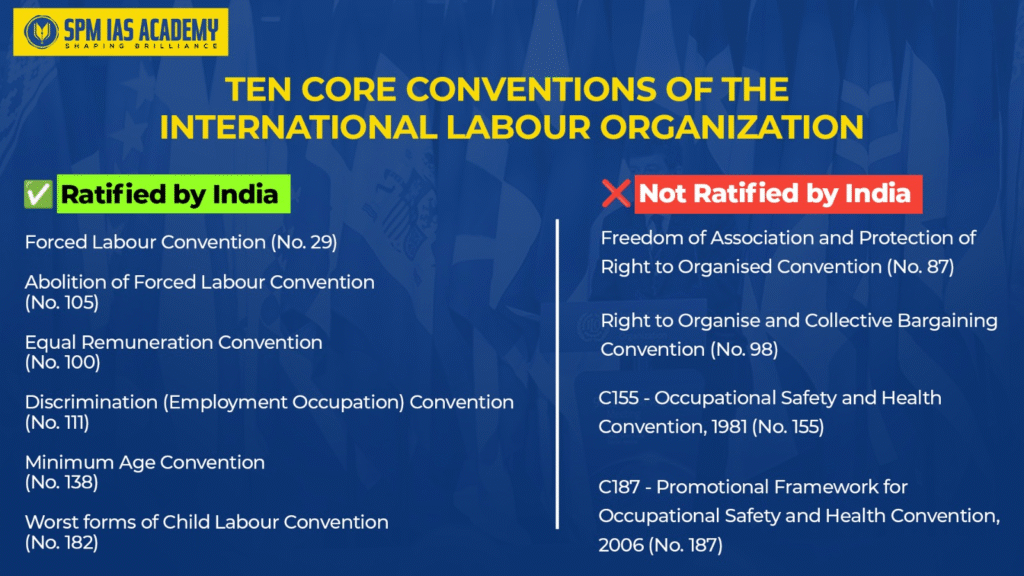Why in the News?
On May 1st, people around the globe observe International Labour Day. This day recognizes the value of work and the rights of workers. In India, it pays tribute to the efforts of workers. It also highlights the necessity for better enforcement of labour laws. The goal is to eradicate bonded and exploitative labour practices.
Exam Relevance
India’s labour productivity is low compared to global peers. This is mainly due to dependence on agriculture. The dominance of informal jobs also contributes to this issue. Additionally, there is limited skill development and inadequate technology use. These factors reduce competitiveness and slow industrial growth. They also hinder the effective use of India’s large workforce. To address these challenges, the government has introduced measures like the Skill India Mission, Make in India, Digital India, and various labour reforms. Understanding productivity trends is essential for solving economy-based questions in SSC, Banking, and state PSC exams.
Introduction
The government of India recently revealed that 17 crore jobs have been created over the last ten years. However, achieving the nation’s goal of becoming a $36 trillion economy by 2047 relies significantly on bridging the large labour productivity gap that exists between formal and informal workers. This disparity constrains income growth. It also hinders economic inclusion. Therefore, a substantial structural change in the labor market is important.
What is the Current Status of India’s Labour Force?
1. In 2024, the overall Labour Force Participation Rate (LFPR) in India held steady at 59.6%. This reflects a minor decline from the 59.8% recorded in 2023. The information comes from the Periodic Labour Force Survey (PLFS).
2. The Worker Population Ratio (WPR) experienced a slight decrease. It fell from 58.0% to 57.7%.
- Unemployment rates saw a slight rise. They increased from 3.1% to 3.2% across the country.
What are the Current Issues Related to Indian Labour Rights?
Below are the issues faced by India’s labour force currently:
1. Prevalent Informality
According to the National Sample Survey Organization, approximately 39 crore out of India’s 47 crore workforce is employed in the unorganised sector. A lack of job security, formal contracts, and social benefits characterizes this sector.
- Moreover, 9.8% of employees in the organized sector are engaged informally. This underscores the prevalence of outsourcing. It also highlights the vulnerability of workers.
- The formalization of Gross Domestic Product (GDP) has reached 56%. However, the formalization of the labor market lags at just 15%. This information is based on Citi Research from 2024.
- Post-COVID, 54 million new jobs were created. Most of these jobs were in self-employment. They were not in formal wage employment.
2. Dominance of Low-Quality Jobs and Skill Gap
The India Employment Report 2024 from the International Labour Organisation emphasizes several important points. The informal sector mainly consists of low-quality jobs. Migrants and informal workers in this sector often face challenging conditions. These conditions are frequently similar to bonded labour.
- Despite having high-quality educational institutions, only 51.25% of graduates in India are considered employable. This information was revealed in the Economic Survey for 2023-24. The statistics highlight a significant gap in skills within the country.
3. Delayed Implementation of Labour Laws
The execution of the Labour Codes in India has been postponed. This delay is due to trade unions’ concerns about diminished rights and compromised worker protections. Additionally, the preparedness of states to create and enforce the necessary regulations has also played a crucial role in this postponement.
- Gig workers, numbering around 7.7 million as of 2020-21, face several significant challenges. First and foremost, they are excluded from minimum wage laws, which places them in a precarious financial position. Moreover, they do not have protections under occupational safety regulations, further exacerbating their vulnerability. In addition, their exclusion from the Industrial Relations Code of 2020 leaves them without essential rights and protections. As a result, this situation significantly increases their exposure to health risks. Lastly, they also lack access to effective dispute resolution mechanisms, which makes it difficult for them to address any grievances that may arise.
4. Gender Disparities in the Labour Force
The female labour force participation rate (LFPR) dropped from 41.3% in 2023 to 40.3% in 2024. In contrast, the male LFPR increased from 78.3% to 79.2%.
- Urban female unemployment stands at 8.2%. Only 3% of employed women over 25 hold advanced degrees. This highlights the underutilization of educated women and a skills-job mismatch.
5. Low Labour Productivity
India ranks 13th globally for the longest working hours. The average workweek is 46.7 hours. Additionally, over 51% of employees work 49 hours or more.
- However, India’s labour productivity is comparatively low, with a GDP per working hour of USD 8, ranking it 133rd in the world.
- High-pressure work environments are common in corporate sectors. They are contributing to mental health issues among employees.
- Labour productivity is an important indicator of economic growth. It is also essential for competitiveness. Improving labour productivity is crucial for enhancing living standards.
- By 2030, climate change is expected to cause major challenges. It is projected to lead to the loss of over 2% of total working hours globally each year. This will further exacerbate the productivity issue.
What is the Labour Productivity Gap Between Formal and Informal Sectors?
Formal industrial employees contribute approximately ₹12 lakh in Gross Value Added (GVA) per worker each year. In contrast, workers in the informal sector generate only about ₹1.5 lakh annually. This results in a disparity of eight times, highlighting the productivity gap. Almost 91 percent of the workforce operates within the informal sector. In comparison, only 9 percent are employed formally. The low productivity of the informal sector suppresses average earnings. It also obscures the actual economic capabilities of India’s labor force.
What are the Income Inequality and Employment Market Trends?
Economic theory suggests that wages should correspond with productivity levels. However, India’s extensive informal labor sector and underemployment disrupt this connection. The surplus of available labor keeps wages low, even as productivity increases in formal employment. Agriculture employs 42 percent of the workforce but only contributes 18 percent to GDP. This highlights the presence of disguised unemployment and very low marginal productivity. Such disparities hinder wage growth from aligning with advancements in economic output.
How can India improve the Labour Productivity Gap?
Below are some ways India can improve and transform India’s labour force:
1. Enhancing Formalisation
India should prioritize transitioning workers from informal to formal employment. This can be achieved by effectively implementing the Labour Codes, 2020. Additionally, expanding coverage under the Employees’ Provident Fund Organisation (EPFO) and the Employees’ State Insurance Corporation (ESIC) is important.
- Additionally, strengthening schemes like Pradhan Mantri MUDRA Yojana, MSME Udyam, and Employment Linked Incentive (ELI) will promote job creation. Linking these schemes to infrastructure development in Tier 2 and Tier 3 cities will also foster economic growth.
- Formalisation will provide access to worker benefits. These benefits include healthcare, pensions, and job security. This improvement will enhance overall productivity. It will also help reduce inequality.
2. Boosting Skill Development
Enhance the quality and relevance of vocational education through initiatives such as Skill India and the Pradhan Mantri Kaushal Vikas Yojana (PMKVY). Reinforce the connections between industry and academia. Emphasize the importance of digital, green, and soft skills necessary for future employment.
- India can learn from the Irish model. It can focus on fostering a strong connection between education and industry.
3. Revisiting the Labour Codes through Dialogue
India should institutionalize social dialogue mechanisms. One way to achieve this is by reconvening the Indian Labour Conference (ILC).
- Ratifying ILO Convention No. 87 supports freedom of association. Meanwhile, ratifying ILO Convention No. 98 concerns the right to organize and collective bargaining. These actions would promote unionization. This is especially important for workers in the informal sector.
- This would address the challenges faced by these workers. They encounter issues such as a lack of job security, limited bargaining power, and poor working conditions. The aim is to ensure fair wages and improve working conditions.
4. Promoting Gender Equality
Increase female labor force participation through various policies. One such initiative is Beti Bachao Beti Padhao. Another important policy is the Maternity Benefit Act of 2017.
- Provide safe workspaces. Offer flexible hours. Include work-from-home options. Provide childcare support. Implement gender-sensitive policies. These measures can help boost female labor force participation.
5. Enhancing Worker Health and Safety Standards
Occupational health and safety standards need improvement. This is especially important in high-risk sectors. Industries like mining, construction, and textiles require particular attention.
- Ensure strict enforcement of the Occupational Safety, Health, and Working Conditions Code, 2020.
What are the Key Conventions of the International Labour Organization?

How can Performance-Based Wages Boost the Labour Productivity Gap?
Wage models based on performance can create a stronger link between compensation and the quality and efficiency of output. Industries like electronics and textiles can implement these types of systems. Public initiatives, such as MGNREGS, could introduce bonuses tied to performance while still upholding worker rights. Digital technologies, including AI and IoT, can provide objective measurements of productivity. Platforms like ASEEM and DigiLocker can maintain comprehensive worker profiles. These profiles can be used to monitor wages, skills, and career advancement.
Conclusion
India should focus on generating formal, secure, and impactful job opportunities. Investing in human resources is crucial for bridging the labour productivity gap. Promoting gender equality is also important. Formalizing labor will help improve the workforce. Additionally, aligning skills with the needs of emerging industries is crucial. By taking these steps, India can maximize its demographic advantage. Urgent and effective measures are important for developing a workforce prepared for the future.
Frequently Asked Questions
India’s Labour Productivity dropped by 2.80% year-on-year in December 2022. This decrease is in contrast to a growth of 3.99% in the previous year.
The productivity in India is quite low. This is partly due to the large population size of the country. Other factors also contribute to low productivity. These include a lack of proper infrastructure and institutions. Additionally, there is a lack of modern technology and good irrigation facilities.
A productivity gap is the difference between one country’s productivity levels and those of its main competitors. This gap is measured by output per worker or output per hour worked. It highlights how one country performs compared to others that primarily export similar goods.












